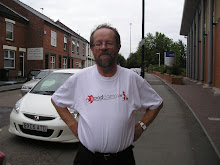Two full-on days. We drove back down to
Northampton yesterday, aiming to arrive for lunch at 12.30 but were already running late by the time we left, and finally got there at 12.45, which was pretty good considering that there’d been delays on the road. Nothing like the last time we went, though.
It was my oldest sister-in-law’s birthday, and Celia had made her a birthday cake, and bought a bunch of food to take. Far too much food, of course, but that’s always the way with any Crowl celebration. We stayed with my other sister-in-law and her husband, again, and I finally remembered to return the key we’d borrowed last time. It was a blisteringly hot day - the hottest we’ve had since we’ve been here perhaps - and major change after all the rain.
The birthday party went off well, though most of them had to retreat in out of the sun because it was too hot. It wasn’t much cooler inside, however. At the end of the day we offered to take my nephew back home to
Milton Keynes. This set up a chorus of ways we should gon to take him there (he doesn’t have his own car at present), and we had to leave in the end, and rely on our Sat Nav as there would have been no consensus from the other four. We went via a back road rather than the M11, and that was much more pleasant, and quicker!
Came home to our hosts and watched
Play Misty for Me, Clint Eastwood’s first outing as director. More of that on my other blog.
Slept in this morning, and finally got away about ten. Arrived home at
Wicklewood some ten hours later!
We wanted to take a quieter route than the one we’d come down on, and also see some other places. Headed to
Wellingborough, which was a pleasant town, with op shops, a church with a spire in the Market Square, and a market in progress. In the church there are a number of new stained-glass windows - new in the sense that they were made in the 20th century. The creator of a couple was
John Piper, and these are startlingly beautiful in a modern way, when the sun is shining through them. The woman who greeted us and talked to us about the place said that the minister who’d been there for some forty years (if I remember rightly) had had a way with getting people to part with their money and help improve the church. Consequently it has a mural over one altar painted by a Dutchman called
Hans Feibusch (the woman said she’d never got to like it, even though she’d been longer than it has), the several stained-glass windows and several other modern works. Unfortunately the church is in a bad way outside, with the stonework deteriorating rapidly.
We went on to
Oundle - don’t ask me how to pronounce it - where all the houses and buildings seemed to made of the same light-grey stone. There was such a uniformity about the colour that it almost didn’t seem real. Probably a very pleasant place, but that stage it was very hot again, and we didn’t stay long. Another church with a spire. (The Norman and Saxon towers aren’t much in evidence around here.)
We were going to go to
Peterborough, but didn’t make it due to the fact that we decided to look up my cousin who, with another woman, runs a Christmas tree business. She also works at a full-time job. It took us two or three attempts to get to the place: for some reason our Sat Nav took us to a completely wrong place, recommending we pull into a private driveway where three houses were situated. Two little dogs gave a sort of effort to warn me off, but it was too hot for them to be really bothered. The man gave me fairly clear instructions, and we allowed Malvina to offer to put us on the right road as well, and eventually we got to the place - after first driving up a farm road that ran straight into a field.
My cousin wasn’t home when we arrived, so we walked around the house - and found a photo of one of my NZ uncles was up on the wall, which confirmed that we had the right place at least. And then, after we’d had a cup of coffee, my cousin suddenly turned up as we were about to leave, telling us my NZ uncle was coming along behind with the other woman - on bikes. He’s only 82.
Finally, after this, we headed straight home. It was a couple of hours of travel, and finished up taking us back down the road we’d come from
King’s Lynn on Thursday.














